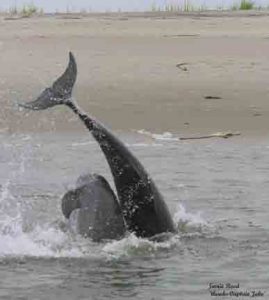post
Porpoises vs Dolphins

One of the best parts of being a naturalist is that moment when we first spot a dolphin swimming towards our tour in the Kiawah River. Whether it is during a kayaking or motorboat excursion, our Atlantic Bottlenose Dolphins steal the show once they are caught strand feeding, playing, or simply swimming around freely in the waters next to us. We are lucky to be spoiled by such terrific dolphin action by our resident pod of about 25 dolphins (including a newborn calf born early this summer). A common question asked by my guests seems to be “what is the difference between a dolphin and a porpoise”? I usually mention the main difference between the two (“beak” length) but it turns out these two creatures are quite different from each other in more than just one way.
Porpoises are confused with dolphins because of their overwhelming morphological similarities, which makes sense due to the fact that they are closely related. While I used to think that porpoises had a shorter beak than dolphins, it turns out that they lack much of a beak at all. There are about 40 different species of dolphins that have long pointed snouts, while the 6 species of porpoise have flattened faces, almost like that of a fish. Porpoises are generally smaller and stouter, which explains how the name porpoise originated–from the Latin porcus, meaning pig and piscus, meaning fish. Of course, dolphins and porpoises are not fish at all, but rather marine mammals that evolved millions of years ago from land mammals that entered the water.
Some other morphological differences between these cetaceans include teeth shape. Porpoises have spade shaped teeth, while dolphins have pointy conical tooth. The dorsal fin can also give clues about the difference between the two–dolphins have a curved dorsal fin, while the porpoise fin is strictly triangular. Another interesting difference is that dolphins tend to be more chatty with each other and make sounds using their blowholes. Porpoises have not been found to do this due to differences in the anatomy of their blowhole. Finally, porpoises are shy creatures. They are not as likely to jump (breach) out of the water like dolphins, but instead only come to the surface to breathe. Amidst all the differences between these animals, one thing remains certain; the two are both extremely intelligent. Dolphins and porpoises have very large and complex brains, allowing them to perform echolocation with a special part of their brain (melon) for navigation and hunting. We can be sure that whether we are looking at a dolphin or a porpoise, the two are fascinating and unique each in their own way.
August through November is the best time to experience Kiawah’s dolphins. Join our Naturalists on a Dolphin Encounters motorboat excursion offered daily through the Heron Park Nature Center.
-Naturalist Laura Willhoft